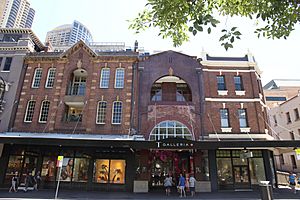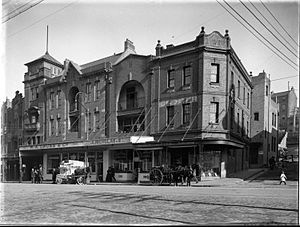147 George Street, The Rocks facts for kids
Quick facts for kids 147 George Street, The Rocks |
|
|---|---|

147 George Street is located second from right, pictured in 2019.
|
|
| Location | 147 George Street, The Rocks, City of Sydney, New South Wales, Australia |
| Built | 1914 |
| Architectural style(s) | Federation Free Classical |
| Owner | Property NSW |
| Official name: Shop and Residence; Currently part of Duty Free Store complex | |
| Type | State heritage (built) |
| Designated | 10 May 2002 |
| Reference no. | 1585 |
| Type | Shop |
| Category | Retail and Wholesale |
| Lua error in Module:Location_map at line 420: attempt to index field 'wikibase' (a nil value). | |
147 George Street, The Rocks is an old building in Sydney, Australia. It's located at 147 George Street in a historic area called The Rocks. This building used to be a shop and a home, but now it's part of a bigger duty-free store complex.
It was built in 1914 and is owned by Property NSW, which is a government agency in New South Wales. Because of its history and special features, it was added to the New South Wales State Heritage Register on 10 May 2002.
Contents
History of 147 George Street
The land where 147 George Street stands has a long history. Records from 1807 show that a surgeon and a captain lived on this spot. Around 1835, a Mrs. Underwood owned stone shops and houses here. By 1845, a two-storey brick house and shop were built. This house was described as having "every convenience."
In 1861, one of the buildings became a "Bowling Alley." Later, in 1871, a pub called the "Nil Desperandum Hotel" opened. Over the years, more shops and homes were built and changed. In 1891, some buildings were pulled down, and new ones were built.
The whole area was taken over by the government in 1900 under the Observatory Hill Resumption Act. This happened after a plague outbreak, as part of a plan to improve health and living conditions. The New York Hotel, which was nearby, was knocked down in 1907.
In 1914, the old building at 147 George Street was demolished. The current three-storey brick building was then built in its place during the same year.
What 147 George Street Looks Like
This building is a simple but impressive three-storey structure made of dark bricks. It was built in 1914 in a style called Federation Free Classical. This style was popular around the time Australia became a federation.
A key feature of the building used to be a large, curved, two-storey verandah opening. However, this was changed a lot in the 1980s when a new curved awning and entrance were added. The building also has small amounts of sandstone used in its decoration, like on the top of the gable and in the keystones (the wedge-shaped stone at the top of an arch).
The original shopfront, which had a central entry and tiles, was removed in the 1980s. This was done to create a large, two-level entrance for the modern development built behind the site.
Changes Over Time
- 1988: The building became part of the DFS complex. This involved knocking down the back of the building, removing the inside, and creating new shopfronts.
- Late 1980s: A large commercial building was built behind 145-155 George Street. The front parts (facades) of the existing buildings were updated to fit with this new development.
Why 147 George Street is Important
147 George Street is important because of its history and its social value. It's part of a group of four buildings that stand together on George Street.
Historic Importance
- Early Settlement: This site has been used by Europeans since at least 1791, making it a very old part of Sydney's history.
- Urban Renewal: The building shows how The Rocks area changed over the 20th century.
- After the 1900 plague, many old buildings were demolished, and new ones were built to be healthier. 147 George Street was part of this rebuilding.
- It's also linked to big construction projects like the Cahill Expressway and the City Railway link. These projects changed how the area looked.
- In the 1980s, The Rocks was turned into a major tourist spot. The inside and back of 147 George Street were changed to create the Duty Free Store complex.
Design and Appearance
The front of 147 George Street, especially the second floor and above, is important because it still looks much like it did when it was built. It's a good example of a commercial building in the Federation Free Style. The large arch on the front is quite unusual for buildings of this time. Even though changes were made in the 1980s, they used the arch design to match the older style of the street.
This building is part of a group that acts like a "gateway" to The Rocks area when you enter from George Street. Their traditional style stands out against the more modern buildings around Circular Quay.
Community Connection
The Rocks area is very important to the people of Sydney and New South Wales. The community fought hard to "Save The Rocks" from being completely redeveloped. This area is a popular place for both locals and tourists because of its historic feel.
147 George Street, as part of The Rocks, helps create this special feeling. It has always been a place for shops and retail, continuing the area's long history as Sydney's first commercial district, especially linked to the port and shipping. Today, it continues this tradition through tourism.


